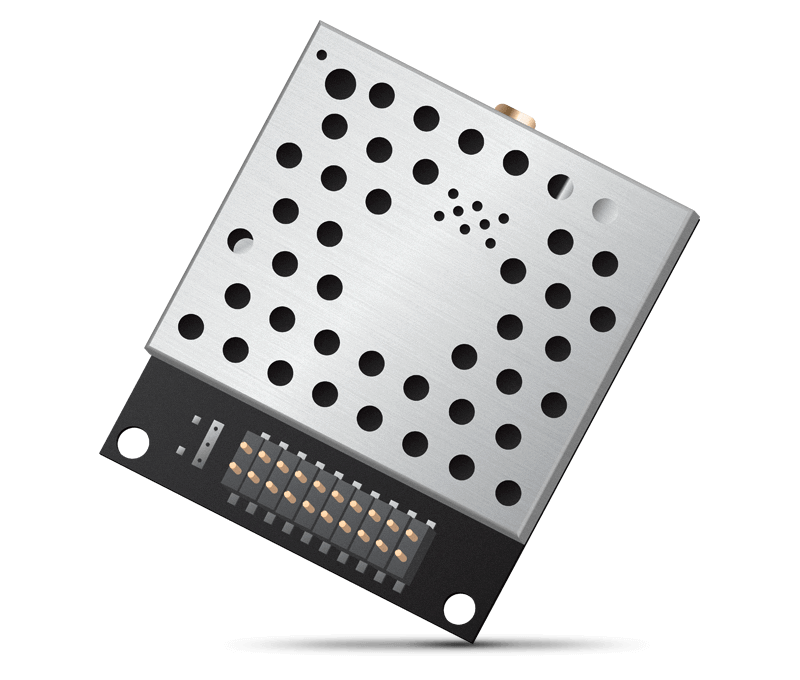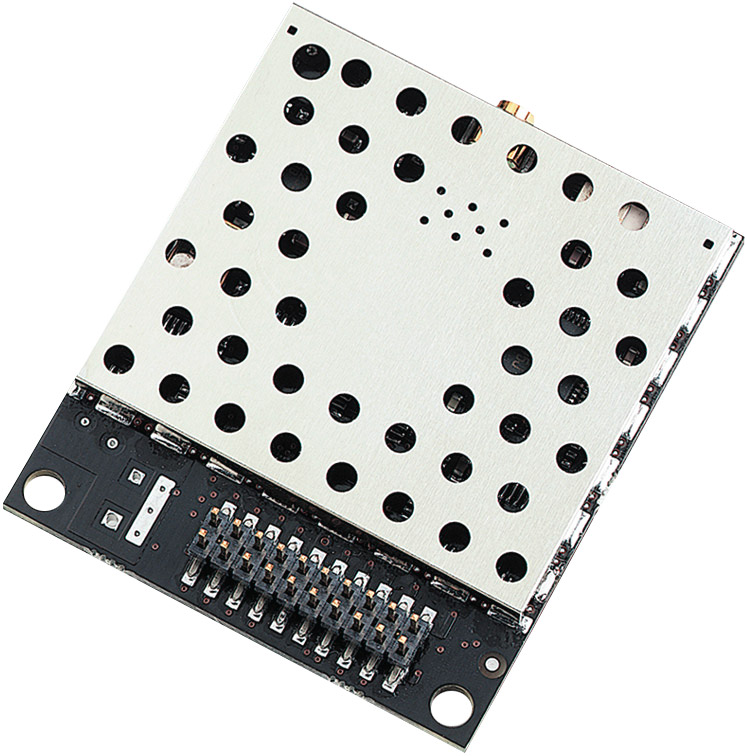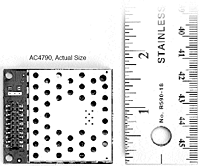AC4790 Series

Overview
The high-performance AC4790 radio modules utilize Laird's masterless protocol, allowing each radio module to communicate with any other in-range radio module for true peer-to-peer operation. Using field-proven 900MHz FHSS technology that needs no additional site licensing*, AC4790s reject interference, enable co-located system operation, and ensure data integrity. The AC4790's protocol features a dynamic addressing scheme, that simplifies node-to-node communication. The radio module enables identification of the most efficient transmission path, so OEMs can design routing sequences that optimize the RF network. This makes the AC4790 ideal for a wide variety of industrial applications that must rely on smooth, constant data flow. Developer tools and comprehensive technical support are available to aid integration. Let Laird help you find the best fit for your application.
Note: Some variants of the AC4790 and related DVK and SDK variants have reached end of production and are available on a limited basis only. Find the End of Life Announcement in the Documentation tab below. Only the following part numbers are affected:
- AC4790-1000M-485
- AC4790-200A
- AC4790LR-200M
Buy Now
Specifications
Part Number
| Price @ 1k
| Antenna Options
| Antenna Type
| Channels
| Chipset (Wireless)
| Compliance
| Connector
| Data Rate
| Dimension (Height - mm)
| Dimension (Length - mm)
| Dimension (Width - mm)
| Frequency
| Frequency Range (Max)
| Frequency Range (Min)
| Input Power
| Logical Interfaces
| Network Architecture
| OS/Software
| Operating Humidity
| Output Power
| Power Consumption
| Power Consumption (Rx)
| Power Consumption (Tx)
| Product Type
| Protocols
| Receive Sensitivity
| Security
| Storage Humidity
| System Architecture
| Technology
| Weight
| Wireless Specification
|
|---|---|---|---|---|---|---|---|---|---|---|---|---|---|---|---|---|---|---|---|---|---|---|---|---|---|---|---|---|---|---|---|---|
| N/A | External | 32 Channels US/Canada | TI CC1010 | None | 76.8 Kbps | 5.08 mm | 48.26 mm | 41.91 mm | 902 - 928 MHz US/Canada 915 - 928 MHz Australia, US/Canada (optional) | 928 MHz | 902 MHz | Pin 10: 3.3 - 5.5V -50 mV ripple, Pin 11: 3.3 -3%, -100 mV ripple | UART | Peer-to-peer | Configuration and Test Software | 10% - 90% | 743 mW - 1486 mW | Up to 1300 mA | 30 mA | 1300 mA | Embedded Module | -110 dBm | 10% - 90% | Hosted | Proprietary RF (9xx MHz) | |||||||
| N/A | External | 16 Channels US/Canada, 8 channels, Australia/US/Canada | TI CC1010 | None | 76.8 Kbps | 5.08 mm | 48.26 mm | 41.91 mm | 928 MHz | 902 MHz | 3.3 - 5.5V, -50 mV ripple | UART | Peer-to-peer | Configuration and Test Software | 10% - 90% | 5mW-200mW variable | Up to 106 mA | 106 mA | 38 mA | Embedded Module | -100 dBm | 10% - 90% | Hosted | Proprietary RF (9xx MHz) | ||||||||
| N/A | MMCX Connector | External | 32 Channels | TI CC1010 | None | 20-Pin Mini Connector | 76.8 Kbps | 5.08 mm | 48.26 mm | 41.91 mm | 928 MHz | 902 MHz | 3.3 V | UART | Peer-to-peer | Configuration and Test Software | 10% - 90% | 743 mW - 1486 mW | Up to 1300 mA | 30 mA | 1300 mA | Embedded Module | FHSS Wireless Protocol | -110 dBm | One-byte system ID | 10% - 90% | Hosted | Proprietary RF (9xx MHz) | .705 oz (20 g) | 900 MHz FHSS |
Documentation
Product Brief 1 total
Name |
Part |
Last Updated |
|---|---|---|
| Product Brief - AC4790 | All | 08/15/2024 |
Datasheet 1 total
Name |
Part |
Last Updated |
|---|---|---|
| Datasheet - AC4790 Module | All | 07/19/2024 |
Application Note 1 total
Name |
Part |
Last Updated |
|---|---|---|
| Application Note - Updating USB Serial Drivers for RAMP Products | All | 07/23/2024 |
Software 1 total
Name |
Part |
Last Updated |
|---|---|---|
| Configuration and Test Utility Software v6.07 | All | 07/23/2024 |
Documentation 7 total
Name |
Part |
Last Updated |
|---|---|---|
| Configuration and Test Utility Software - RAMP Modules | All | 07/22/2024 |
| EOL - Multi/Mass - Sept 21 | All | 09/08/2021 |
| EOL - RAMP - Nov-15-2015 | All | 03/01/2019 |
| PCN 7B-2022 - AC4x90-1000M | All | 09/15/2022 |
| PCN #7A-2024 - AC4x90 R3 and rebrand Ezurio | All | 07/19/2024 |
| PCN #8A-2024 - AC4x90-200M-01 | All | 08/08/2024 |
| User Guide - AC4790 Module | All | 07/19/2024 |
Certification 4 total
Name |
Part |
Last Updated |
|---|---|---|
| FCC - AC4x90-1000M AC4x90LR-1000M Revision 2.0 Hardware | All | 11/08/2022 |
| ISED (Canada) - AC4x90-1000M AC4x90LR-1000M Revision 2.0 Hardware | All | 11/08/2022 |
| RoHS 3 - Bluetooth | All | 03/06/2025 |
| RoHS 3 - RAMP ISM Modules | All | 03/06/2025 |
Become an Ezurio Customer to Gain Exclusive Access to Our Design Experts
- Antenna Scans
- Antenna selection and placement
- Custom antenna design
- Worldwide EMC testing / certifications
- Embedded RF hardware / firmware design
- Cloud architecture and integration
- Mobile application development
- Product & Industrial Design
Distributors
| Distributor | Phone Number | Region | Website |
|---|---|---|---|
| Arrow Electronics | 1-855-326-4757 +44 2039 365486 |
APAC, North America, South America, EMEA | Website |
| Braemac Australia, New Zealand, South East Asia | +61 2 9550 6600 +64 9 477 2148 |
APAC | Website |
| DigiKey | 1-800-344-4539 |
North America, South America, APAC, EMEA | Website |
| EBV Elektronik | EMEA | Website | |
| Farlink Technology China, Hong Kong | +86 13266922199 |
APAC | Website |
| Farnell | 1-800-936-198 +44 3447 11 11 22 |
EMEA | Website |
| Future Electronics | 1-800-675-1619 1-514-428-8470 |
North America, South America, APAC, EMEA | Website |
| Glyn | +49-6126-590-0 |
EMEA | Website |
| Hy-Line Germany Only | +49 89 614 503 0 |
EMEA | Website |
| Jetronic China, Hong Kong and Taiwan | 852-27636806 |
APAC | Website |
| M2M Germany | +49-6081-587386-0 |
EMEA | Website |
| Martinsson | +46 8 7440300 |
EMEA | Website |
| McCoy South East Asia | +65 6515 2988 |
APAC | Website |
| Mouser Electronics | 1-800-346-6873 +44 1494 427500 |
North America, South America, APAC, EMEA | Website |
| RS Components | +852-2421-9898 +44 3457-201201 |
North America, South America, APAC, EMEA | Website |
| Ryoyo Japan | +81-3-3543-7711 |
APAC | Website |
| Solsta UK Only | +44 (0) 1527 830800 |
EMEA | Website |
| Supreme Components International India, South East Asia | +65 6848-1178 |
APAC | Website |
| Symmetry Electronics | 1-866-506-8829 |
North America | Website |
| Tekdis Australia and New Zealand | +61 3 8669 1210 |
APAC | Website |
| Telsys | +972 3 7657666 |
EMEA | Website |
| WPG | +44 1628 958460 |
EMEA | Website |
 Laird Connectivity is now Ezurio
Laird Connectivity is now Ezurio



/filters:background_color(white)/2019-06/ramp-ism-module_0.png)